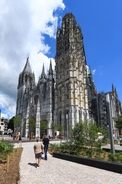A fire which ravaged Notre-Dame Cathedral yesterday made headlines all over the world. Around 400 firefighters worked tirelessly, for nine hours, before it was finally declared that the fire had been extinguished. But this wasn’t before the spire - and most of the roof - had been destroyed by the blaze.
Luckily, no one was hurt. However, the entire planet has been engulfed in news about the fire. So just why are people from Miami to Manilla pouring their hearts out over this French Cathedral? Here’s why Notre-Dame is so important.

Located in the 4th arrondissement of Paris, Notre-Dame is almost 700 years old. Construction began in 1163 but the building wasn’t complete for nearly 200 years. As well as the fire, it has lived through countless wars and, more recently, attempted terror attacks in 2016 and 2017 respectively.

A tapestry of culture, the cathedral has been added to over hundreds of years. However, its roof dates all the way back to the beginning. The timber frame involved around 52 acres of trees that were cut down in the 12th century. The lattice was therefore nicknamed "the Forest".

If you imagine cartoon characters when someone says “Notre-Dame”, you’re probably thinking of the Disney version of The Hunchback of Notre-Dame, which was penned by Victor Hugo in the early 1800s and adapted countless times. The deaf hunchback, Quasimodo, is a bell-ringer at Notre-Dame and the story follows his quest for the love of the beautiful Esmerelda who - like the cathedral - is referred to as “Our Lady of Paris”.

Notre-Dame sits on the island Île-de-la-Cité in the River Seine. This was once the centre of Paris’ predecessor - the Gallo-Roman city known as Lutetia. It’s thought that the cathedral may have been built directly on top of the site of a temple dedicated to Jupiter.

Until yesterday, the spire had a barely visible-rooster on top of it which had an unusual purpose. In 1935, Archbishop Jean Verdier allegedly placed inside the metal rooster a piece of the Crown of Thorns and some bits of Saint-Denis and Saint Genevieve, Paris’ patron saints. A spiritual lightning rod, it was intended to protect the congregation below.

Napoleon Bonaparte was coronated at Notre Dame in 1804. He went on to fight a number of wars and colonised much of Europe. He was eventually defeated at the battle of Waterloo, against the British, and sent to exile on the remote South Atlantic island of Saint Helena where he died six years later.

Had the wooden frame of the north tower caught fire, the weight of the 13-tonne Emmanuel Bell could have brought both of its twin towers down. Previous iterations of Notre-Dame’s 10 bells were melted down for artillery.

This colossal cathedral is 130 metres (425 foot) long and 48 meters (157 foot) wide. It also had a spire height of 91 metres (300 foot) before it sadly collapsed due to the fire. Its roof had 1,326 tiles, weighing in at 210,000 kilos. A total of 1,300 trees, many between 300 and 400 years old, went towards its construction.

Dragging the building into the 21st century, the west facade of the building has been used to project light shows onto. Last year, Dame de Coeur lit the building up with a dazzling light and sound show to mark 100 years since the end of World War One.

The cathedral was lovingly referred to as “the poor man’s book” as its ornate exterior told stories that many people were too illiterate to read in books. In addition to gargoyles which watch over the city, the statues and engravings tell various biblical stories and above the central portal of the west facade is a huge reimagining of the Last Judgement.

President Emmanuel Macron has promised the French people that Notre-Dame will be restored to its former glory and hundreds of millions of euros have already been pledged to rebuild the world heritage site. Luckily, the fire only destroyed history and not lives.


